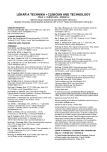-
Články
- Časopisy
- Kurzy
- Témy
- Kongresy
- Videa
- Podcasty
Technical solutions of semi-closed circuits for heliox administration in spontaneously breathing patients with severe airway obstruction
A semi-closed circuit represents a cost effective alternative of heliox application in patients with severe airway obstruction. A semi-closed circuit has its intrinsic resistance that compromises the positive effect of heliox in the obstructed airways. The resistance may be reduced and depends on the design of the circuit. The article proposes two alternative configurations of semi-closed circuits for heliox application differing in their resistive properties and complexity of their construction.
Keywords:
heliox, helium, respiratory care, semi-close circuit, COPD, airway resistance, work of breathing
Autoři: Barbora Němcová; Karel Roubík
Působiště autorů: Czech Technical University, Faculty of Biomedical Engineering, Prague, Czech Republic
Vyšlo v časopise: Lékař a technika - Clinician and Technology No. 2, 2014, 44, 30-33
Kategorie: Původní práce
Souhrn
A semi-closed circuit represents a cost effective alternative of heliox application in patients with severe airway obstruction. A semi-closed circuit has its intrinsic resistance that compromises the positive effect of heliox in the obstructed airways. The resistance may be reduced and depends on the design of the circuit. The article proposes two alternative configurations of semi-closed circuits for heliox application differing in their resistive properties and complexity of their construction.
Keywords:
heliox, helium, respiratory care, semi-close circuit, COPD, airway resistance, work of breathing
Zdroje
[1] Hess, D.: Heliox and Noninvasive Positive-Pressure Ventilation: A Role for Heliox in Exacerbations of Chronic Obstructive Pulmonary Disease? Respiratory Care 2006, 51(6):640-650.
[2] Gupta, V. K., Cheifetz, I. M.: Heliox administration in the pediatric intensive care unit: an evidence-based review. Pediatric Critical Care Medicine 2005. 2(6): 204-11.
[3] Frazier, M. D, Cheifetz, I. M: The role of heliox in pediatric respiratory disease. Peadiatr Respir Rev 2010, 11 : 46-53.
[4] Roche-Campo, F., Vignaux, L., Galia, F., Lyazidi, A., Vargas, F., Texereau, J., Apiou-Sbirlea, G., Jolliet, P., Brochard, L.: Delivery of helium–oxygen mixture during spontaneous breathing: evaluation of three high-concentration face masks. Intensive Care Med 2011, 37 : 1787-1792.
[5] Roubík, K., Zazula, R., Strnadová, A., Zábrodský, V., Spálený, A., Muller, M., Chlumský, J., Tyll, T.: Spontaneous breathing of heliox using a semi-closed circuit: A bench study. The International Journal of Artificial Organs 2012. 35(6): 466-470.
[6] Strnadová, A., Zazula, R., Zábrodský, V., Spálený, A., Roubík, K., Horáková, Z.: Zhodnocení efektu helioxu na dechovou práci spontánně dýchajícího pacienta u polouzavřeného ventilačního okruhu. Lékař a technika 2009. 38(4): 46-51.
[7] van Heerde, M., Roubik, K., Kopelent, V., Plötz, F. B, Markhorst, D. G. Demand flow facilitates spontaneous breathing during high-frequency oscillatory ventilation in a pig model. Crit Care Med. 2009; 37 : 1068-1073.
[8] Roubik, K., Rafl, J., van Heerde, M., Markhorst, D. G. Design and control of a demand flow system assuring spontaneous breathing of a patient connected to an HFO ventilator. IEEE T Bio-Med Eng. 2011; 58 : 3225–3233.
Štítky
Biomedicína
Článok vyšiel v časopiseLékař a technika

2014 Číslo 2-
Všetky články tohto čísla
- Liposomy, jejich charakterizace, příprava a inkorporace do nanovlákenných nosičů
- Deconvolution-based Physiological Signal Simplification for Periodical Parameter Estimation
- Respiratory Rate Estimation in Postoperative Care-State of the Art and Perspectives
- Technical solutions of semi-closed circuits for heliox administration in spontaneously breathing patients with severe airway obstruction
- Analýza povrchu magnetických mikročástic prostřednictvím mikroskopie atomárních sil
- Neparametrické statistické testy a jejich softwarová podpora
- Lékař a technika
- Archív čísel
- Aktuálne číslo
- Informácie o časopise
Najčítanejšie v tomto čísle- Liposomy, jejich charakterizace, příprava a inkorporace do nanovlákenných nosičů
- Neparametrické statistické testy a jejich softwarová podpora
- Analýza povrchu magnetických mikročástic prostřednictvím mikroskopie atomárních sil
- Technical solutions of semi-closed circuits for heliox administration in spontaneously breathing patients with severe airway obstruction
Prihlásenie#ADS_BOTTOM_SCRIPTS#Zabudnuté hesloZadajte e-mailovú adresu, s ktorou ste vytvárali účet. Budú Vám na ňu zasielané informácie k nastaveniu nového hesla.
- Časopisy



